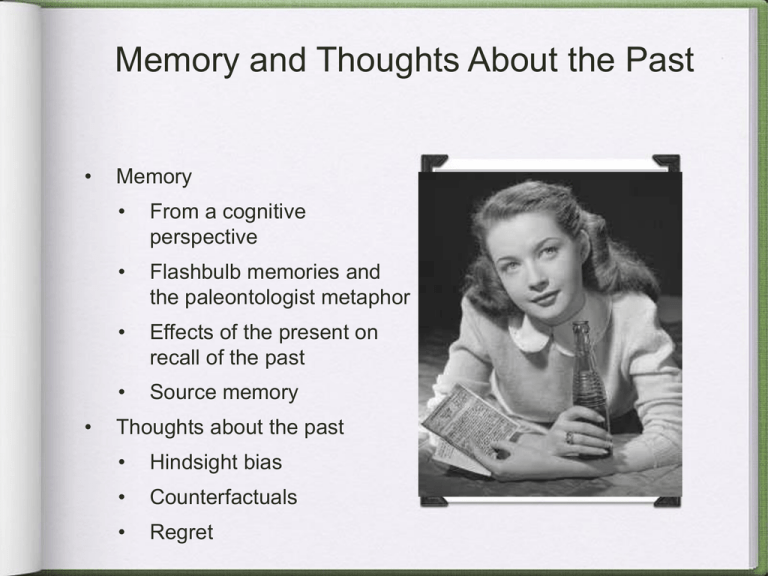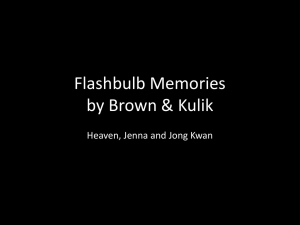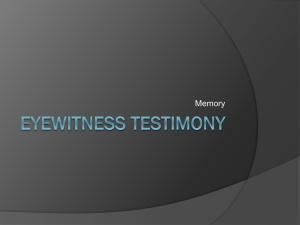Memory and Thoughts About the Past
advertisement

Memory and Thoughts About the Past • • Memory • From a cognitive perspective • Flashbulb memories and the paleontologist metaphor • Effects of the present on recall of the past • Source memory Thoughts about the past • Hindsight bias • Counterfactuals • Regret • From the cognitive perspective... • ..let us hear a list of words Memory Performance • Recognition (e.g., “Did you hear ‘thread’ on the list?) is easier than recall (e.g., write down all the words you can remember) • People remember more information when it is more easily organized into categories or structure is easily created (e.g., when words related to each other are grouped together in a list), at least when their explicit memory is tested... Implicit vs. Explicit Memory • Explicit Memory: involves awareness of previous exposure, e.g. “I know that the word thread was on the list.” • Implicit Memory: influence of previous exposure of experience, without conscious recollection; “priming” • e.g., Word stem completion task • TH_ _ _ Implicit vs. Explicit Memory: Evidence • Amnesiacs: Recall and Recognition: Amnesiacs < Controls Word stem completion, i.e., “TH _ _ _” : Amnesiacs = Controls Implicit vs. Explicit Memory: Evidence • Becoming famous overnight (Jacoby et al., 1989)... • Part 1: pronounce 40 non-famous names (e.g., Sebastian Weisdorf) • Part 2: test either immediately or 24 hours later • moderately famous names and non-famous names (some old--e.g., Sebastian Weisdorf--and some new-e.g., Frank Chandler) • “Is this person famous?” Implicit vs. Explicit Memory: Evidence • Becoming famous overnight (Jacoby et al., 1989)... • Results: • Immediate test: Mistakes LESS common for old non-famous names (e.g., Sebastian Weisdorf) than new ones (e.g., Frank Chandler) • 24 hours later: Mistakes MORE common for old non-famous names (e.g., Sebastian Weisdorf) than new ones (Frank Chandler) Semantic vs. Episodic Memory • Semantic Memory: Knowledge (e.g., water freezes at 0 degrees, the order of the planets, what “dissonance reduction” means, that your roommate is irresponsible) • Episodic Memory: Memory of a particular episode in your life; e.g., memory of the specific occasion on which you acquired a piece of knowledge • “I remember the day when I learned that water freezes at 0. I was sitting in at my desk in my thirdgrade classroom and Mrs. Hopkins was standing in front of the class, and she said...” • “I remember my first day at university. I arrived on campus at about 11 am. We were in my mom’s old car and all of my stuff was piled in the back...” “Flashbulb Memories” (Brown & Kulik, 1977) Vivid and detailed memory of hearing about an important news event • "You remember exactly where you were… …when you heard the news…. You can probably tell us where you were, with whom, and very likely whether you were sitting, standing, or walking--almost which foot was forward when your awareness became manifest" (Livingston, 1967, p. 576) “Flashbulb Memories” U.S. President Lincoln’s Assassination (Colgrove, 1899) • “My father and I were on the road to Augusta in the State of Maine to purchase the ’fixings’ needed for my graduation. When we were driving down a steep hill into the city we felt that something was wrong. Everybody looked so sad, and there was such terrible excitement that my father stopped his horse, and learning from the carriage called: ‘What is it my friends? What has happened?’ ‘Haven’t you heard?’ was their reply--’Lincoln has been assassinated.’ The lines fell from my father’s limp hands, and with tears streaming from his eyes he sat as one bereft of motion. We were far from home, and much must be done, so he rallied after a time, and we finished our work as well as our heavy hearts would allow.” “Flashbulb Memories” • 1941: Japanese attack on Pearl Harbor (Neisser, 1982, 1986; Thompson & Cowan, 1986) • 1963: Assassination of US President John Kennedy (Winograd & Killinger, 1983; Yarmey & Bull, 1978) • 1986: Assassination of Swedish Prime Minister Olaf Palme (Christiansson, 1989; Larsen, 1992) • 1989: Hillsborough Soccer Riot (Wright, 1993) • 1990: Resignation of British Prime Minister Margaret Thatcher (Cohen, Conway & Maylor, 1994) • 2001: September 11 attacks (Talarico & Rubin, 2003) • 2002: April 11 ? “Flashbulb Memories” The 1986 Challenger Explosion (Neisser & Harsch, 1992) "I was in religion class and some people walked in and started talking about [it]. I didn't know any details except that it had exploded and the schoolteacher's students had all been watching which I thought was so sad. Then after class I went to my room and watched the TV program talking about it and I got all the details from that." "When I first heard about the explosion I was sitting in my freshman dorm room with my roommate and we were watching TV. It came on a news flash and we were both totally shocked. I was really upset and I went upstairs to talk to a friend of mine and then I called my parents." Flashbulb? “Flashbulb Memories” The 1986 Challenger Explosion (Neisser & Harsch, 1992) Confidence... Mean = 4.17 on a scale of 1 - 5 “Phantom Flashbulbs” The 1986 Challenger Explosion (Neisser & Harsch, 1992) Accuracy.... M = 2.95 out of 7 25% were wrong about everything 50% were wrong about 2/3 of what they recalled only 7% received perfect scores no significant correlation between confidence and accuracy 0 1 2 3 4 5 6 7 • The Paleontologist Metaphor The process of remembering is like a paleontologist trying to (Neisser, 1967) construct a dinosaur from a a few fossilized bones (i.e., “memory traces”) and theories of paleontology (i.e., general knowledge structures and other factors...). • In other words.....Memory is reconstructive. • So, what you recall can be influenced by factors in the present. Schema •A concept or framework, built up from experience, about any object, event, person or group. Schemata influence the way we interpret, organize, communicate, and remember information. “T.V. Priority”: Schemata in the Challenger Study • Only 21% of subjects had actually first heard about the news on TV • BUT, two years later, 45% believed they had first heard about the news on TV Schemata and Memory (Anderson & Pichert, 1978) • • Subjects asked to adopt a particular identity: • Home-buyer • Burglar Then read a passage about two boys playing hooky from school... Schemata and Memory (Anderson & Pichert, 1978) [Coding: Burglar items (18); Homebuyer items (18)] There are three color TV sets in the house. One is in the large master bedroom (which has a three piece bathroom en suite), one is in the main floor family room, and one is in Tom's bedroom. The house contains four bedrooms in all, plus an office, family room, and three washrooms. In addition to the TV, the family room contains a new stereo outfit , a microcomputer, a VCR, and a rare coin collection. The boys enter the master bedroom. Beside the jewelry case in the closet they find Tom's father's collection of pornographic video tapes. They select their favorite (an encounter between a guy and 12 women in a park in downtown Kitchener) and go to the family room to watch it. Schemata and Memory (Anderson & Pichert, 1978) Proportion Recalled Recall #1 Identity Items Schemata and Memory (Anderson & Prichert, 1978) Change in proportion recalled Distracter task....then....switch perspectives and try to recall again First identity/second identity Items Other influences of the Present on reconstruction of the past • • • Mood • Mood-congruent memory Goals/Motivation • Information that fits with desired conclusion is more likely to be recalled (e.g., Sanitioso, Kunda, & Fong, 1990; if told that extraversion leads to success recall more examples of your own extraverted behavior; opposite if told that introversion leads to success) Cognitive biases • positive-test strategy • It’s not just what you recall that matters, but also how you think you encountered that information in the first place... Eyewitness • Loftus and Palmer (1974) • Film of car accident • How fast were the two cars going when they hit* each other? • *smashed, collided, bumped, contacted Eyewitness • Hit: 34 • Smashed: 41 • Collided: 39 • Bumped: 38 • Contacted: 32 Follow up • One hundred and fifty • Smashed: • Hit: • Not asked: • 1 week later: Did you see broken glass? Follow up • 1 week later: Did you see broken glass? • Smashed: 32% • Hit: 14% • Not asked: 12% One more • Loftus and Zanni (1975) • Did you see a broken headlight? • Did you see the broken headlight? One more • Loftus and Zanni (1975) • Did you see a broken headlight? • Did you see the broken headlight? YES • But there was no broken headlight… Yearkes-Dawdson Law Other factors • Age: young children and older males more likely misled • Stress • Expectations • Exposure time (lofus (1987): 30 second bank robbery) • Detail salience (loftus 1987): gun or none; gun tended to focus on the weapon and not other details… • Loftus and Burns (1982): violent; shock will mess up recall Problems with Loftus • Misinformation effect (McCloskey and Zaragoza, 1985) • Loftus 1975-video in which 8 demonstrators interuppted a lecture. Half were asked was the leader of the 12 demonstrators male? Others: was the leader of the 4 demonstrators male? • A week later: • 12 demos: Average 8.9 demonstrators • 4 demos: Averaged 6.4 Implications • Geiselman (1984): Basic cognitive interview • May be a number of retrieval paths; therefore different cues • Memory trace has several features • Improved by fisher in 1987 • 1990-45 % more correct responses • Miami 93% more data collected • Wilkinson (1988) EWT of kids could be raised to adults. Face recognition • Standing 1973 • 10,000 faces over 5 days • Paired pictures-one they had seen, one they had not • Right 98% of the time. • Bahrick (1975): Yearbook • 15 year later: one in five the had graduated with • Right 90 % of time • Even 40 years, they were right 75% Source Monitoring Framework (Johnson, Hashtroudi, & Lindsay, 1993) • Some source monitoring dilemmas... • Did Susan tell me that, or did George? (distinguishing between two external sources) • Did I say that, or only think it? (”reality monitoring”: distinguishing between something that actually occurred vs. something you only imagined) • • • According to the Source Monitoring Framework: Memories are NOT tagged with labels indicating their source Source is judged “online” in the present, based on.... Source Monitoring Framework (Johnson, Hashtroudi, & Lindsay, 1993) • • • Source is judged “online” in the present, based on.... Memory Characteristics • amount of perceptual, temporal, and spatial detail (generally more for real than for imagined events) • type of perceptual details (e.g., auditory memory of voice) • information about cognitive operations (generally more for imagined than for real events) General knowledge • “money doesn’t grow on trees” • stereotypes Influence of memory characteristics on source monitoring (Johnson, Raye, Wang, & Taylor, 1979) • Procedure: • Subjects viewed 36 pictures 2, 5, or 8 times each and also imagined those pictures 2, 5, or 8 times each • Later they were asked to estimate how many times they had seen each picture. Influence of memory characteristics on source monitoring (Johnson, Raye, Wang, & Taylor, 1979) • The more times they had imagined the picture, the more frequently they thought they had actually seen it • Effect was stronger for good imagers than poor imagers Influence of “general knowledge” on source monitoring (Johnson, Raye, Wang, & Taylor, 1979) • Stereotypes (Sherman & Bessenoff, 1999) • • Attribute information in stereotype consistent manner, especially when under cognitive load Beliefs about choice: “I chose the better option” • “Misremembrance of options past”: Blind dates and Job candidates (Mather, Shafir, & Johnson, 2000) Source Errors in “Real Life”? • Marge: Hurry up, Homer. It’s time to go to the reunion • Homer: Yeah, it will be great to see the old gang again--Potsy, Ralph Malph, The Fonze... • Marge: Homer, that wasn’t high school, that was Happy Days! • Homer: No, they weren’t all happy days--like that time Pinky Tuscadero crashed her motor bike and that time I lost all that money to those cardsharps and my dad, Tom Bosley had to bail me out... Evaluate your memory: Did you recall these words? Thread Web Knitting Spider Needle Crawl • • • • • • • • • • • • • • • Thread Pin Eye Sewing Sharp Point Prick Thimble Haystack Thorn Hurt Injection Syringe Cloth Knitting Web Insect Bug Fright Fly Arachnid Crawl Tarantula Poison Bite Creepy Animal Ugly Feelers Small QuickTime™ and a TIFF (Uncompressed) decompressor are needed to see this picture. Creating your own false memory • Study for exam in Psych: • You focus on"positive reinforcement" and "schedules of reinforcement," • you may well falsely recognize the term "negative reinforcement" Implanting memories of whole events? • It happens in the movies.... Memory Implantation: Total Recall (1990) Truman show Eternal sunshine of the spotless mind How researchers implant memories... (Hyman, Husband, & Billings, 1995) • Contact parents to get 2 - 4 real childhood events, verify that 1 target false event did not occur • Interview subjects 3 times each, with one day between each interview • At each interview, ask for information regarding 3 - 5 childhood events; 1 event is the target false event (e.g., knocked over the punch bowl at a wedding) • Subjects told that parents reported all events to have happened • How likely are subjects to report to actually remember the false event? How researchers implant memories... (Hyman, Husband, & Billings, 1995) How researchers implant memories... (Hyman, Husband, & Billings, 1995) “Imagination Inflation” (Garry, Manning, Loftus, & Sherman, 1996) • Session 1: • • • Fill out “Life Events Inventory” (LEI) where rate how certain that 40 events happened in own childhood Session 2: Two weeks later, participate in “experiment on imagination” • Guided through imagining 4 events from LEI (e.g., broke a window with your hand, found a $10 bill in parking lot, got in trouble for calling 911) • At the end experimenter says that original LEI ratings were lost and could they please fill out the form again Question: Among subjects who initially rated target events as unlikely, how does imagining events affect certainty ratings? “Imagination Inflation” (Garry, Manning, Loftus, & Sherman, 1996) Relevance: Recovered Memories of Child Abuse • Incidences of people “recovering” memories of childhood abuse that they claim had not been aware of before, “repressed memories” • Childhood abuse is not infrequent (estimates range from 10% to 50% of children; Loftus, 1993) • There are documented cases of “recovered memories” being true • HOWEVER, when recovered in the context of therapy, recovered memories of abuse may be suspect... Therapy: Imagining What Might Have Happened •"Using all the details you do know, create your own story. Ground the experience or event in as much knowledge as you have and then let yourself imagine what actually might have happened." •~Bass & Davis, Courage to Heal "Whether what is remembered is made up or real is of no concern at the beginning of the process; that can be decided at a later date." ~Renee Fredrickson, Repressed memories: A journey to recovery from sexual abuse Therapy: Influencing Beliefs and “General Knowledge” •SYMPTOM CHECKLISTS Do you have trouble knowing what you want? Are you afraid to try new experiences? If someone gives you a suggestion, do you feel you ought to follow it? Do you follow other people's suggestions as if they were orders to be observed? Do you feel different from other people? Do you have trouble feeling motivated? Do you feel you have to be perfect? Do you use work or achievements to compensate for inadequate feelings in other parts of your life? "We have found that the Aftereffects Checklist can serve as a diagnostic device for suggesting sexual victimization when none is remembered." ~E. S. Blume, Secret survivors: •Uncovering incest and its after-effects in women Hindsight Bias •A projection of new knowledge into the past accompanied by a denial that the outcome information has influenced judgment. (Hawkins & Hastie, 1990) •“The US government should have known the September 11 attacks were coming” •“Wasn’t it obvious that Arnie would become the next governor of California?” •“That woman should have known that if she walked home by that route she was bound to get assaulted.” Hindsight Bias and Causal Thinking •Outcome seems obvious after the fact because we can reinterpret prior events in light of the outcome and create a causal chain; overlook the fact that these particular elements did not stand out before you knew the outcome... •“What we don’t hear about is all the other people whom American intelligence had under surveillance, how many other warnings they received, and how many other tips came in that seemed promising at the time but led nowhere. The central challenge of intelligence gathering has always been the problem of “noise”: the fact that useless information is vastly more plentiful than useful information.... the F.B.I.’s counterterrorism division has sixty-eight thousand outstanding and unassigned leads dating back to 1995. And, of those, probably no more than a few hundred are useful.” •~Malcom Gladwell, on 1998 Kenyan Embassy bombing, •in The New Yorker (2003) Hindsight Bias and Causal Thinking • Thinking about alternate outcomes, “counterfactuals,” can reduce hindsight bias, but not always... Counterfactual Thinking: What might have been •Counterfactuals: Mental representations of alternatives to the past •Upward counterfactuals: alternative pasts that are better than reality, e.g. , “It could have been a brilliant career” •Downward counterfactuals: alternative pasts that are worse than reality, e.g., “At least I didn’t fail.” •Three aspects of counterfactual thinking: •Emotional impact •Clues to causality •Functionality Counterfactual Thinking: Emotional impact (Medvec, Madey, & Gilovich, 1995) • Silver and Bronze medal winners: Who is happier? • Silver is objectively better of, but counterfactuals predict the opposite: • • Silver: upward counterfactual, “I almost won.” • Bronze: downward counterfactual, “At least I didn’t lose!” Reactions of 1992 Olympic athletes show that Bronze medal winners are happier







